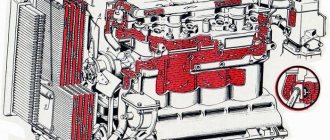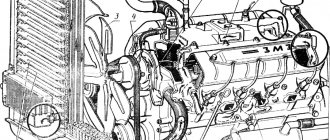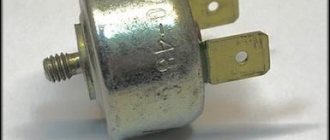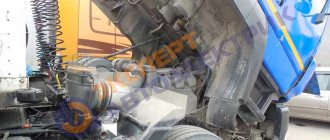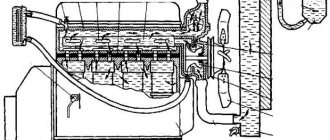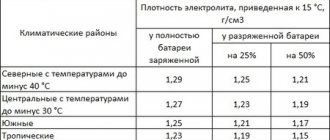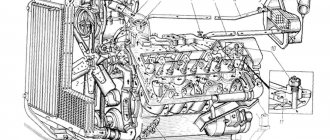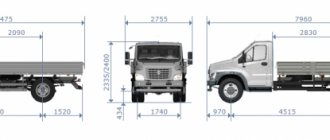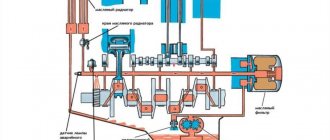8 ..
Engine cooling system UMZ-42164-80
Rice. 12 Cooling system diagram. 1 — interior heater radiator; 2 — radiator valve; 3 - water jacket; 4 - block head; 5 - gasket; 6 — inter-cylinder channels for the passage of coolant; 7 — thermostat; 8 - thermostat housing; 9 — thermostat housing pipe (large circulation circle); 10 — steam outlet pipe; 11 — expansion tank; 12 — filler plug; 13 - o; 14 — coolant temperature sensor; 15 — pipe for draining fluid from the expansion tank; 16 — cooling system pump; 17 — water pump impeller; 18 — cooling system fan; 19 — two-way radiator of the cooling system; 20 — water pump pipe; 21 — radiator drain plug
The first control circuit consists of an automatically operating thermostat, which regulates the amount of fluid entering the radiator. Depending on the position of the thermostat valve, the ratio of the flow of liquid passed into the radiator for cooling and returned back to the engine changes. The second control loop is implemented by controlling the operation of the electromagnetic clutch of the fan drive, due to which the amount of air passing through the radiator grilles changes. The electromagnetic clutch is turned on and off by a relay according to commands received from the controller.
During operation, coolant must be poured and topped up into the cooling system through the expansion tank 11 by opening the filler cap 12. The liquid vapors formed in the system and the released air are removed from the radiator and thermostat housing through the steam exhaust tube 10. In order to prevent the occurrence of cavitation during pump operation 16 its suction cavity is connected to the expansion tank using a pipe 15.
For normal engine operation, the temperature of the coolant at the outlet of the head must be maintained within the range of plus 81° - 89°C.
Short-term operation of the engine at a coolant temperature of 105° C is permissible. This mode can occur in the hot season when driving a car with a full load on long climbs or in urban driving conditions with frequent accelerations and stops.
The operating temperature of the coolant is maintained using a single-valve thermostat with solid filler T-118-01 installed in the housing.
When the engine warms up, when the coolant temperature is below 80°C, a small circle of coolant circulation operates. Thermostat valve 7 is closed.
The coolant is pumped by a water pump into the cooling jacket 5 of the cylinder block 6, from where, through holes in the upper plate of the block and the lower plane of the cylinder head, the liquid enters the cooling jacket of the head 3, then into the thermostat housing 14 and into the supply branch of the interior heating radiator 1. Depending From the position of the interior heating valve valve 2, the coolant either through the heating radiator or bypassing it enters the connecting pipe and then to the inlet of the water pump. The two-pass radiator 19 of the cooling system is disconnected from the main flow of coolant. The fluid circulation scheme implemented in this way makes it possible to increase the efficiency of heating the cabin when the fluid moves in a small circle (this situation can be maintained for quite a long time at low negative ambient temperatures).
When the liquid temperature rises above 80°C, the thermostat valve opens and the coolant circulates in a large circle through a two-way radiator.
For normal operation, the cooling system must be completely filled with liquid. When the engine warms up, the volume of liquid increases, its excess is pushed out due to increased pressure from the closed circulation volume into the expansion tank. When the fluid temperature decreases (after the engine stops running), the fluid from the expansion tank, under the influence of the resulting vacuum, returns to the closed volume.
The coolant level in the expansion tank should be 3-4 cm above the “min” mark. Due to the fact that the coolant has a high coefficient of thermal expansion, and its level in the expansion tank varies significantly depending on the temperature, the level should be checked at a temperature in the cooling system of plus 15 ° C.
The tightness of the cooling system allows the engine to operate at a coolant temperature exceeding plus 100°C. When the temperature rises above the permissible level (plus 105°C), the temperature alarm is activated (red lamp on the instrument panel). When the temperature indicator lamp lights up, the engine must be stopped and the cause of overheating must be eliminated.
The causes of overheating may be: insufficient amount of coolant in the cooling system, weak tension in the coolant pump drive belt.
Warning. Do not open the expansion tank cap if the coolant in the cooling system is hot and under pressure, otherwise serious burns may occur.
Coolant is poisonous, so it is necessary to prevent liquid from getting into the mouth or on the skin.
The cooling system pump is shown in Fig. 13.
Thermostat housing is made of cast aluminum alloy. Together with the housing cover, it performs the functions of distributing coolant in the external part of the engine cooling system depending on the position of the thermostat valve (Fig. 14)
Rice. 13. Cooling system pump: 1 - hub; 10 - pulley; 3 - body; 4 — clamp; 5 - bearing; 6 — fitting for draining coolant from the heating system; 7 - cover; 8 — impeller; 9 — oil seal; 10 - control hole.
Rice. 14. Thermostat operation diagram: a - position of the thermostat valve and direction of coolant flow when the engine warms up; b - after warming up. 1 — thermostat housing; 2 — fitting for the interior heating radiator (small circle of coolant circulation); 3 - thermostat; 4 — steam outlet fitting; 5 — thermostat housing pipe; 6 - gasket.
Electromagnetic fan shut-off clutch
shown in Fig. 15.
The clutch is turned on and off by a relay according to commands received from the engine control system controller.
After starting the engine at a low coolant temperature, the rotation of the pulley is not transmitted to the driven disk and the associated fan hub 2 with the bearing, because the end of the pulley and the driven disk are separated by gap A. The required clearance is ensured by adjusting the position of the three lobes of the driven disk stop. In the extreme right position, the driven disc is held in place by three leaf springs.
After the engine warms up and the coolant reaches a temperature of plus 89°C, the controller sends a command to the relay to turn on the electromagnetic clutch. The relay closes the contacts and supplies current through the connector to the coil winding. The resulting magnetic flux closes through the driven disk and attracts it to the end of the pulley, overcoming the resistance of three leaf springs. Fan hub 2, as well as the fan itself, begin to rotate together with the pulley.
When the temperature drops below 81°C, the controller turns off the relay, which breaks the power circuit of the coil winding. Under the action of three leaf springs, the driven disk moves away from the end of the pulley by the amount of gap A. The fan hub, together with the fan, stops rotating. When the coolant temperature rises above 89°C, the process is repeated.
Caring for the clutch consists of checking the gap A, and, if necessary, adjusting it using a flat feeler gauge 0.4 mm thick by bending the three stops of the driven disk.
The coupling must be periodically cleaned of dust and dirt. No additional lubrication of the coupling is required during operation.
The power plants of the cars of the Ulyanovsk Automobile Plant include not the newest, but simple, proven reliability and popular gasoline engine UMZ-4218. Read about this motor, its characteristics, existing modifications, design features and applicability in this article.
Characteristics, types and applicability of UMZ-4218 engines
In the early 90s, the Ulyanovsk Automobile Plant began to feel an acute shortage of powerful and reliable engines that could provide new UAZ vehicles with better speed characteristics and cross-country ability. By 1993, based on the UMZ-4178 unit, a new UMZ-4218.10 engine was developed and put into production, which was distinguished by its large volume and torque for passenger cars. However, this unit had a number of “childhood diseases” that were “cured” with the subsequent modification - UMZ-421.10. Subsequently, on the basis of the new engine, a whole family of power units was created, which today are used in UAZ and GAZelle vehicles.
UAZ vehicles with a UMZ-417 engine use a liquid, closed cooling system, with forced circulation of coolant by a centrifugal pump of the cooling system. On the UAZ-3151 and some other models, depending on the configuration, a pre-starter can be installed, integrated into the cooling system. Low-freezing liquid is used as a coolant.
For normal operation of the UMZ-417 engine, the coolant temperature must be maintained within 70-90 degrees. This temperature is achieved using an automatically operating thermostat, which regulates the amount of liquid passing through the radiator and blinds, with the help of which they regulate the amount of air cooling the radiator.
Monitoring the coolant temperature in the UMZ-417 cooling system.
To control the coolant temperature, there is an electric one on the instrument panel, the sensor of which is screwed into the cavity of the water pump bracket. In addition, overheating of the coolant is indicated by a warning lamp with a red filter installed on the instrument panel and connected by an electrical wire to a sensor screwed into the upper radiator tank.
The control lamp lights up when the coolant reaches a temperature of 92-98 degrees. When the warning light comes on, the radiator shutters must be opened. The causes of overheating may be:
- low fluid level in the radiator - low fan belt tension - driving with the blinds closed or the insulating cover valve closed
Maintenance of the UMZ-417 engine cooling system.
The coolant level in the expansion tank is checked on a cold engine; it should be 30-40 mm above the “Min” mark. When the level of low-freezing liquid decreases as a result of its boiling, it is necessary to add clean water to the cooling system, since water evaporates from the liquid first, due to the fact that the boiling point of water is much lower than ethylene glycol. If the liquid level decreases as a result of leakage, it is necessary to add low-freezing liquid after eliminating the cause of the leakage.
The low-freezing liquid in the UMZ-417 engine cooling system is replaced every 2 years or after 60,000 kilometers. Before adding fresh fluid, it is recommended to flush the cooling system with clean water. Liquid is drained from the cooling system through two taps. One is located on the lower radiator tank, the other on the cylinder block, or, if a pre-heater is installed on the UAZ, then on its boiler.
Cooling system water pump maintenance.
Centrifugal type, driven by a V-belt from the crankshaft pulley. The pump design uses a ball-roller bearing, manufactured integrally with the pump shaft. The bearing has special seals that ensure preservation of the lubricant incorporated during manufacture. The bearing does not require additional lubrication during operation. Coolant leakage through the inspection hole indicates a faulty seal.
Some UAZ vehicles with UMZ-4178 and UMZ-4179 engines can be equipped with a water pump whose design uses ball bearings. In such pumps, the cavity is sealed using a rubber cuff, which is tightly pressed by a spring to the sealing washer and the pump shaft.
The bearings of such a water pump are lubricated after one regular maintenance with Litol-24 type grease through a grease nipple until the grease comes out of the control hole. Excess grease must be removed as it may get on the fan belt.
It is checked by pressing it between the pulleys of the water pump and the generator with a force of 39 N. The belt deflection should be within 8-14 mm. To adjust the tension belt, you need to loosen the fastening bolts, move it in the required direction, tighten the bolts and check the belt tension again.
Checking the operation of the cooling system thermostat.
A locking-type thermostat with a solid filler is located in the outlet pipe located on the bracket of the cooling system pump, and operates as a result of the movement of the rod in the thermostat cylinder. The thermostat valve begins to open at a coolant temperature of 69-72 degrees and fully opens at a temperature of 81-85 degrees. The thermostat, by turning the radiator on or off, automatically maintains the required temperature of the coolant in the engine.
Operating the UMZ-417 engine without a thermostat is unacceptable, since when it is removed, the main flow of coolant will circulate through a small circle of the cooling system, bypassing the radiator, which will lead to overheating of the engine.
The operation of the thermostat is checked simultaneously with flushing the cooling system, as well as during systematic overheating of the engine, and when the power and ignition systems are working properly. To check, the thermostat and thermometer are placed in a vessel with water heated to a temperature of 90-100 degrees. Then, as the water gradually cools, the temperature at which the thermostat valve begins and ends is controlled. The faulty thermostat is replaced with a new one.
You can also check the serviceability of the thermostat by heating the inlet pipe of the upper radiator tank when the engine warms up. If the thermostat is faulty, this pipe warms up immediately after starting the engine; if it is working properly, it will warm up after the water temperature in the engine cylinder block reaches 60-70 degrees according to the water temperature indicator on the instrument panel.
Cooling system radiator plug.
It seals the radiator hermetically and communicates with the cooling system to the expansion tank only through the exhaust and intake valves. The exhaust valve opens when the pressure in the cooling system increases to 44.1-58.8 kPa and releases coolant or vapor into the expansion tank. The inlet valve opens at a vacuum in the system of 0.98-9.8 kPa and admits coolant from the expansion tank into the radiator.
The radiator cap seal prevents vapors or coolant from escaping through the gap between the radiator neck and the radiator cap locking spring. For normal operation of the radiator cap, it is necessary that the valve gaskets and the gasket between the radiator neck and the lock spring are in good condition.
Cooling system fan and fan drive clutch.
Four-blade, prefabricated, attached to the hub of the water pump. The fan is driven together with the water pump by a V-belt from the crankshaft. Some UAZ vehicles can be equipped with a viscous fan drive clutch designed to reduce fuel consumption, reduce fan noise, facilitate warming up of a cold engine and maintain engine thermal conditions within optimal limits.
In the gap between the driving and driven parts of the clutch there is a high-viscosity working fluid, through which rotation is transmitted from the clutch shaft mounted on the hub of the cooling system pump pulley to the clutch housing and the fan mounted on it. The clutch is turned on and off automatically depending on the air temperature behind the radiator. The coupling is not dismountable.
If the bypass hole is clogged, the clutch stops engaging or does not engage fully, and the engine may overheat. To eliminate this malfunction, unscrew the coupling from the hub, remove the fan and unscrew two pins from the coupling housing. Then it is necessary to drain the working fluid through the holes for the studs and thoroughly rinse the internal cavity of the coupling with gasoline.
Allow the gasoline to drain completely and pour 40 grams of polymethylsiloxane liquid PMS-10000 into the coupling through one of the holes. The second hole must be kept open for air to escape. After this, screw the studs into the housing, secure the fan and install the coupling on the hub of the cooling system pump pulley. It should be taken into account that the connection between the coupling shaft and the hub has a left-hand thread. The outer surface of the coupling should be kept clean.
Cooling system shutters.
Installed in front of the radiator. The blinds are controlled from the driver's seat using a rod. When you pull the pull handle toward you, the blinds close, and when you retract them, they open.
Checking and servicing cooling system shutters.
The blinds are checked for complete opening with the drive handle pushed in all the way. If the blinds do not open completely, then the following operations must be performed:
- loosen the screw securing the drive rod in the articulated coupling of the lever located on the blinds - fully open the blinds by turning the drive lever counterclockwise - push the blinds drive handle all the way in and secure the drive rod in this position in the hinged coupling of the lever - check whether they open completely and the blinds are closed by pushing the drive handle in or out
If the drive handle moves with great effort, then it is necessary to lubricate the axes of the blinds and the rod. The rod is lubricated by first removing it from the shell and cleaning it. In the cold season, in addition to the blinds, it is recommended to install an insulating cover with a folding valve.
Replacing the coolant in the UMZ-417 cooling system.
When draining the liquid, the radiator cap is removed, the heater fill funnel plug is turned out and the heater valve is opened. The remaining liquid in the expansion tank and the hose connecting it to the radiator is removed through a disconnected hose from the radiator or by lifting the tank above the radiator.
In the absence of low-freezing liquid, it is allowed to use clean water, if possible not hard, in order to avoid intense scale deposits, which will lead to engine overheating and increased fuel consumption. In this case, when the ambient temperature is below 0 degrees, the hose connecting the radiator to the expansion tank must be disconnected from the expansion tank and directed downwards to remove steam from the radiator. The presence of water in the expansion tank at subzero temperatures is not allowed.
Flushing the cooling system of the UMZ-417 engine.
As water is used as a coolant, the efficiency of the cooling system decreases noticeably as a result of scale deposits on its internal surfaces and, as a result, deterioration of water circulation in the system. In this case, the cooling system must be flushed. The engine and radiator are washed separately so that rust, scale and sediment from the engine cooling jacket do not clog the radiator. Before flushing the engine, you must remove the thermostat.
The direction of the jet when flushing should be opposite to the direction of water movement during normal operation of the cooling system. It is prohibited to use alkaline solutions to wash the cooling jacket of the engine block, as they cause corrosion of the engine head and cylinder block.
UAZ "Bukhanka" is an all-wheel drive off-road vehicle. This model has been produced since 1957. This machine is used not only for its intended purpose, after all, it is a special equipment, but it is also used by fishing and hunting enthusiasts.
The main advantage of this car is its versatility and enormous off-road capabilities. The cabin can accommodate 10 passengers, and if necessary, it can be transformed as desired. The heart of the car is the ZMZ-402 and ZMZ-409 engines. Since the car is special, many are interested in how the cooling system of the UAZ “Loaf” works.
Water / antifreeze / antifreeze gets into the engine oil - causes and consequences | Technoaktiv Invest
The oil in the crankcase takes on the appearance of a white emulsion
There are several ways to determine water in oil, all of which apply to almost all types of lubricants. First, let's determine where the water in the engine lubrication system comes from.
Signs of water in oil
So, let's start with the fact that the engine is still faulty, and the liquid gets there against its will. There are several signs by which this can be recognized:
- Decreasing antifreeze . The first thing to check in case of such suspicions is the coolant level . A gradual decrease in the volume of coolant is not scary and may indicate either a breakdown in the gasket, a leak in the main line connection bridges or microcracks in the hoses. An exchange of antifreeze and oil can also occur in the heat exchanger due to a leak in the seal.
- Changed shade of oil . Everything is not so simple here, because such things can only be seen with a “stuffed” eye . On the other hand, it is not difficult to see that the oil becomes rusty . The fact is that parts oxidize in the presence of water, and the oil actually contains rust.
- White coating on the dipstick . In this case, the proportion of water in the oil is already quite large. It’s not even advisable to start the engine here; there’s probably no need to explain why.
- Engine oil “shoots” when it is boiled in a metal container. If there is no water, then the oil will simply smoke .
- The color and saturation of the exhaust gases change , they become white and billow with thick steam. In winter, it is this steam that confuses drivers - try and determine whether antifreeze has gotten into the oil or is it from the frost.
RECOMMENDATIONS FOR REPAIRING THE ENGINE COOLING SYSTEM
FINDING ENGINE FAULTS AND WAYS TO ELIMINATE THEM
Reasons why water or antifreeze gets into the oil
- Leaky cylinder block gasket This phenomenon is often referred to as a “burnout” of the gasket, and such a “breakdown” can be directed both outside and inside the block. Diagnostics When the cylinder head gasket (cylinder head) burns out towards the engine compartment , the location of the leak of antifreeze or other liquid from the cooling system can be easily determined by the drip. This is provided that the engine is supervised and washed regularly. Especially cultured drivers, in order to quickly identify leaks of various fluids circulating in the engine, paint it in heat-resistant silver and regularly wash the engine itself. On silver, all leaks are detected instantly, which allows you to quickly eliminate the problem . Of course, it is impossible to quickly determine anything on a dirty engine. But freshly squeezing antifreeze out from under the head there is a chance to see it. But the gasket can not only burn out, but also burn out from inside the block, and then the antifreeze will actually go into the oil . It is difficult to determine such a malfunction, but it is possible if you inspect the machine daily and look closely at all changes in its operation.
Operating a machine is a very aggressive environment for engine operation. Constant vibrations, fuel quality, humidity of incoming air and a huge list of reasons why an engine can fail. However, first let's look at how water gets into the oil.
As mentioned above, one of the signs is a decrease in coolant . If this is the case, then there are several options:
- Leaking cylinder head . It happens that the gasket “breaks”, accompanied by a characteristic whistle, so it can be diagnosed quite easily.
- Leakage of pipes . This is also a common problem, but there are quite a few places where the coolant comes into contact with the oil. It's also easy to determine. Leakage is possible in the main connection bridges or through microcracks in the hoses.
- An exchange of coolant and oil can also occur in the heat exchanger due to a leak.
- Crack in the engine jacket . There is nothing you can do to help here, such details only need to be changed .
But it also happens that water in oil is not a consequence of a malfunction, but the natural course of things . This often manifests itself during short trips, especially in winter, and in summer, not everything is so smooth . So, let's look at each season separately.
RECOMMENDATIONS FOR REPAIRING THE ENGINE COOLING SYSTEM
FINDING ENGINE FAULTS AND WAYS TO ELIMINATE THEM
Operation in winter
The problem with winter is the low outside temperature. They started the engine, warmed it up, did some work with the equipment, returned and installed the equipment. Perhaps this is the most common scenario for using technology for your own needs.
So, above the oil level in the engine there is free space that is filled with air . It doesn't matter where he comes from, he just exists. But at the same time , its humidity is usually higher than in the external environment, because oil covers all internal parts .
And it uses so-called esters, they are designed to play the role of a kind of silicone in order to maintain lubricating properties . So these same esters are very hygroscopic . This means that they absorb moisture .
Thus, over time, the air humidity in the engine crankcase reaches 90 percent.
So, we warmed up the engine, this moisture begins to evaporate from the walls, and after cooling it becomes condensate, which gradually flows down, that is, into the oil pan, into the oil . As already mentioned, the main problem is the low temperature “overboard”, which means that arterial condensate accumulates faster . The situation is especially aggravated when the piston group wears out .
The fact is that circulating the same amount of water in the crankcase is not as critical as constant replenishment. Crankcase gases that break through the piston rings also have a certain amount of moisture, which means the overall concentration increases.
General device
These cargo-passenger cars with carriage layout use closed-type liquid cooling. The coolant circulates in the system forcibly under the influence of a centrifugal pump. The manufacturer recommends using domestic Tosol as coolant. However, in emergency cases, you can fill the cooling system of the UAZ “Loaf” with ordinary water. The volume, including not only the cooling system circuits, but also the heater, on most models ranges from 13.2 to 15.3 liters.
List of car models in which it was installed
The UMZ 417 engine was designed specifically for the Ulyanovsk Automobile Plant, therefore it was used in UAZ cars:
- 3151 – SUV;
- 3303 – all-wheel drive truck;
- 3741 – all-metal 4x4 van;
- 2206 – 8 – 11 seat minibus;
- 3962 – ambulance and resuscitation vehicle;
- 3909 – Carriage type farmer;
- 39094 – Farmer truck;
- DISA-1912 Zaslon - an armored vehicle for collectors.
The motor was created a little later than the renaming of UAZ 469 to 3151, and UAZ 452 to 3741, so it is only available in the modernized “Bobiki” and “Tabletki” - “Loaves”. The characteristics of the engine made it possible to use it as a power drive for all UAZ models produced at that time.
Cooling system diagram for ZMZ-402
It's quite simple. This power unit is cooled by liquid that passes through two circuits.
The system is built according to a ring scheme and consists of several main components. The liquid moves from the radiator through the pipes to the thermostat, then passes through the engine cooling jacket. Then, through the water pump, it returns to the radiator. In addition, the cooling system of the UAZ “Loaf” with a 402 engine includes an electric fan, a temperature sensor, and heaters. Let's look at each element separately.
Thermostat
This is the most delicate component in the system. It fails most often - modern spare parts are not of very high quality. The function of the thermostat is to control the flow of coolant through the engine. The ZMZ-402 unit, like many others, has two coolant circulation circles - large and, accordingly, small.
When the driver starts the engine and it warms up a little, the liquid in the cooling system of the UAZ “Loaf” circulates only in a small circle. This allows the engine to warm up faster. When the temperature reaches approximately 70 degrees, the thermostat will work and coolant will flow through the cooling radiator in a large circle. Operating temperatures for the 402 engine range from 82 to 90 degrees. If the engine does not warm up to these temperatures, this indicates that the thermostat is faulty. Often, due to wear, it jams and does not open.
Equipment replacement
If you decide to replace the heater yourself, you should first familiarize yourself with the UAZ Bukhanka stove diagram to connect the electrical component. It is not difficult to install the equipment itself, securing it in the conventional engine compartment located inside the car. But even here you should adhere to certain rules and recommendations. The process will be considered using the example of using NAMI equipment, which has better performance and also boasts the presence of a cabin filter, which is not present in the standard Bukhanka heater.
- The first step is to drain the antifreeze from the system and also disconnect all existing wiring. To make it easier to reassemble and connect, you can write down all your steps or mark the wires, pipes and hoses;
- You need to disconnect the console from the shield, then remove the heating unit, remove the air intake flap, remove the seal and thoroughly clean all existing open recesses;
- Take measurements under the air filter, placing its housing against the surface. Next, make several mounting holes. Just don't use a drill with a diameter larger than 3.2 millimeters;
- At the installation site, apply a layer of high-quality automotive universal sealant that is resistant to moisture and sudden temperature changes. Make the layer large enough. Install the filter housing and secure it. The filter itself can already be inserted into its mounting slot;
- A new heater is being installed in the interior. It is fixed with studs, nuts and an M6 bolt. Secure everything as securely as possible;
- Then the console is installed, the entire structure is mounted on self-tapping screws;
- Then you can start connecting the control rod and fixing it;
- Connect all pipes through which antifreeze passes. For reliability, it is recommended to tighten them with clamps;
- Don’t forget about the channels that allow you to blow on the windows, avoiding them from fogging when the car is used in conditions of high humidity or precipitation. Every car should have windshield defrost. Be it a latest generation Mercedes or the good old Bukhanochka produced by UAZ;
- The installation is completed by connecting the electrical component. There is a connection diagram here that is worth considering separately.
In reality, there is nothing particularly difficult about changing the standard heating system on Bukhanka and installing more efficient and productive equipment in place of the old stove.
Electrical connection diagram
The system will not be able to operate and heat your Loaf if it does not receive power. There is a special scheme for connection. By acting consistently and carefully, you will be able to power your new stove without any outside help and enjoy the efficient operation of the heater.
- To begin, choose a location to place the mass. The black wire is responsible for ground. It is fixed on any metal surface convenient for you. It is best to do the mass on the body;
- Next comes the positive wire. When connecting it, first disconnect the minus from the battery so that the machine is not under voltage during the work;
- Plus it is recommended to enclose in a corrugated casing. Then the wire is pulled to the safety block, that is, to the block on the Loaf;
- Please note that on a car there are 4 fuses in its block. The last one, that is, the fourth one, is constantly under voltage. You should connect to any of the first three. Just make the connection from above, in front of the standard fuse in the block;
- In principle, at this point the connection of the electrical circuit can be considered complete. Be sure to first check the functionality of the furnace equipment.
It is safe to say that the heating system used on UAZ Bukhanka vehicles has a fairly simple design and layout. Therefore, experienced motorists who are accustomed to doing maintenance, repairs and some modifications with their own hands should not have any problems understanding the Bukhanka heater. But it is extremely important to constantly monitor its performance, carry out preventive measures, and monitor the condition and amount of coolant. Pay special attention to the weakest points of the stove. The owners of Bukhanok themselves include standard faucets among them. The faucet often turns sour, jams and leaks. This is due to the long downtime of the faucet, which drivers simply forget to periodically open, purely for preventive purposes.
Radiator and cooling fan
When the liquid in the cooling system of the UAZ “Loaf” passes through the engine, it will heat up. It must cool down to cool. A radiator is used for this. On these cars, the manufacturer installs mainly copper 3-row radiators. However, owners prefer to install aluminum solutions instead. As reviews note, with them the engine is cooled much more efficiently.
The radiator in the system acts as a cooler. It is cooled by the oncoming air flow when moving. When the car is stationary or moving at low speeds, the air flow is weak and cannot sufficiently blow over the radiator. Then the fan comes into play. In this car it is of a forced type. The element rotates when the engine is running, regardless of the coolant temperature. Thus, it is very difficult to overheat the engine.
Engine tuning options
Since the UMZ 417 carburetor engine has a heavy piston system, tuning is carried out according to the following scheme:
- boring of exhaust seats up to 39 mm and use of valves from 412 internal combustion engines;
- installation of a 51 mm exhaust pipe;
- Replacing the stock camshaft with a city camshaft to increase torque at low speeds.
An important feature of this power drive is that it is limited to 100 hp. With. potential, so even if you replace the carburetor with an injector, tuning will not bring the expected increase in power. Experts recommend a swap for the UMZ 417, that is, replacing the entire internal combustion engine.
Thus, the UMZ 417 motor was copied from the 402 power drive of the Zavolzhsky Motor Plant with minor changes. Even with existing shortcomings, the internal combustion engine serves regularly in UAZ all-wheel drive buses, trucks and SUVs, that is, in very difficult operating conditions.
Cooling jacket and pipes
To connect various components of the cooling system of the 402nd engine of the UAZ “Loaf”, pipes are used. These are rubber products in the form of tubes. The elements are quite reliable, but if they are used for a long time, they wear out and become old. Then the coolant may leak and its level drops. As a result, the motor overheats.
The cooling jacket is a necessary part, without which the engine simply will not cool down. The jacket passes through the entire cylinder block. It acts as a heat absorber. The coolant is then discharged to the radiator.
Engine ZMZ-409
This engine is distinguished by a different valve cover, an improved timing mechanism, and a different cylinder head gasket. The volume of the power unit also increased, which immediately entailed the modernization of the cooling system of the ZMZ-409 UAZ “Loaves”.
The design of the cooling system is typical for internal combustion engines of this design that were ever manufactured at the Zavolzhsky plant. The engine is equipped with a liquid closed forced system. There is also a radiator, a jacket in the cylinder block and in the cylinder head, a pump, an expansion tank, temperature sensors, an electric fan, a heater core and other elements. Note that the operating principle of the cooling system of the 409 UAZ “Loaf” is simple and similar to injection engines. Here the coolant also moves in a large circle and in a small one.
Disadvantages of the system
The standard system has only one advantage - it works. The owners cannot say that it is impeccably reliable. It's all about the quality of spare parts. But all the other advantages that this system has can be safely written off as disadvantages. The 402nd motor has a too low-speed fan - its number of revolutions is strictly limited by the pump. To have enough of them, you need a large radiator. In winter, you have to close this radiator to prevent the engine from freezing. There are also problems with the operation of the heater. Without additional artificial pumping of antifreeze, there is no need to wait for heat.
All these problems can be solved by modernizing the cooling system 402 of the UAZ “Loaf” engine (replacing the radiator with a multi-section one, installing a second stove, and so on). Many owners modify it, increasing its efficiency.
So, we found out how the cooling system of the UAZ “Loaf” with the engine of the 409th and 402nd models works. The device is very simple, but the reliability of the system leaves much to be desired, as the owners say.
The UMZ-421 engine cooling system is liquid, closed, with forced circulation of liquid and an expansion tank, with liquid supply to the cylinder block. For normal engine operation, the coolant temperature must be maintained within plus 80-90 degrees. It is permissible to operate the engine for a short time at a coolant temperature of 105 degrees.
This mode can occur in the hot season when driving a car with a full load on long climbs or in urban driving conditions with frequent accelerations and stops. Maintaining normal coolant temperature is carried out using a two-valve thermostat.
The UMZ-421 engine cooling system includes a water pump, thermostat, water jackets in the cylinder block and head, radiator, expansion tank, fan, connecting pipes, as well as a body heating radiator.
Water pump of the cooling system UMZ-421.
The pump of the UMZ-421 engine cooling system is of a centrifugal type, driven by a V-belt from the crankshaft pulley. Belt dimensions are 10.7x8 mm, belt length on UAZ cars is 1030 mm, on GAZelle cars – 1018 mm. The pump body and cover are made of aluminum alloy. The pump design uses a special double-row ball roller bearing 5НР17124Э.Р6Q6/L19 or 6-5НР17124ЭС30, with a double-sided seal, and a roller instead of inner rings.
Since 1999, water pumps have been using an impeller made of Armlen brand PP SV-30, which has straight radial blades, designation 421.1307032-04, instead of the previously used impeller with backward-curved blades, designation 4022.1307032. As a result of the transition to a new impeller, the performance and supply pressure of the water pump were significantly increased, which ensured reliable operation of the engine cooling system, as well as increased the efficiency of the cabin heating system.
Thermostat type TS-107.
Two-valve, with solid filler, located in the outlet pipe of the cylinder head and connected by hoses to the water pump and radiator. The main thermostat valve begins to open at a coolant temperature of 78-82 degrees, and is fully open at a temperature of 94 degrees.
When the main valve is closed, the liquid in the engine cooling system circulates, bypassing the radiator, through the open additional thermostat valve inside the engine cooling jacket. When the main valve is fully open, the secondary valve is closed and all fluid flows through the radiator.
The thermostat automatically maintains the required temperature of the coolant in the engine by cutting off the circulation of fluid through the radiator. In cold weather, especially at low engine loads, almost all the heat is dissipated by cold air blowing over the engine, and coolant does not circulate through the radiator.
The thermostat cannot be removed from the cooling system, since in the cold season an engine without a thermostat takes a long time to warm up and operates at a low coolant temperature. As a result, its wear accelerates, fuel consumption increases, there is an abundant deposition of tarry substances in the engine, and the normal air temperature in the car interior is not ensured.
In the warm season, in the absence of a thermostat, most of the coolant will circulate in a small circle through the engine cooling jacket, bypassing the radiator. As a result, this will cause the engine to overheat.
Cooling system expansion tank.
On UAZ vehicles, the expansion tank of the UMZ-421 engine cooling system is directly connected to the atmosphere. The regulation of fluid exchange between the tank and the closed volume of the system is regulated by two valves: inlet and outlet, located in the radiator plug. The exhaust valve opens at an excess pressure of 0.45-0.60 kgf/cm2, and the intake valve opens at a vacuum of 0.01-0.1 kgf/cm2.
Circulation of coolant in a small circle.
When the engine warms up, when the coolant temperature is below 80 degrees, a small circle of coolant circulation operates. The upper thermostat valve is closed, the lower valve is open.
The coolant is pumped into the cooling jacket of the cylinder block by a water pump, from where, through holes in the upper plate of the block and the lower plane of the cylinder head, the liquid enters the head cooling jacket, then into the thermostat housing and through the lower thermostat valve and pipe to the inlet of the water pump. The radiator is disconnected from the main coolant flow.
For more efficient operation of the interior heating system when circulating liquid in a small circle, this situation can be maintained for quite a long time at low negative ambient temperatures; there is a throttle hole with a diameter of 9 mm in the liquid outlet channel through the lower valve of the thermostat. Such throttling leads to an increase in the pressure drop at the inlet and outlet of the heating radiator and more intense circulation of liquid through this radiator.
In addition, throttling the valve at the liquid outlet through the bottom valve of the thermostat reduces the likelihood of emergency overheating of the engine in the absence of a thermostat, since the shunting effect of the small circle of liquid circulation is significantly weakened, so a significant part of the liquid will go through the cooling radiator.
Additionally, to maintain the normal operating temperature of the coolant during the cold season, UAZ vehicles have shutters in front of the radiator, with which you can regulate the amount of air passing through the radiator.
Where to pour antifreeze
A car will not be able to function normally without coolant - its systems will simply overheat and fail. But does everyone know what antifreeze is, what its functions are and, most importantly, where it should be poured? We will talk about all this in this article.
So, antifreeze is a special liquid that is poured into the car’s cooling system. The peculiarity is that it is resistant to low temperatures. This is possible thanks to a special composition that includes ethylene glycol and distilled water, which together form dihydric alcohol. In addition, antifreeze contains additives, so-called inhibitors.
These substances are designed to slow down the formation of corrosion on parts with which antifreeze comes into contact. The packaging of all liquids sold indicates the brand of the product and the freezing point. Each make and model of car has its own type of antifreeze. Until recently, the most common of them was antifreeze. Some classify it as antifreeze, while others do not.
But this is also a coolant with a simpler composition, which is usually used by owners of domestic cars.
What is antifreeze for?
Coolant removes excess heat from a running engine during the warm season. And in winter, when there is severe frost, antifreeze does not freeze and does not allow the engine walls to rupture. The coolant circulates through the system thanks to a special pump. It passes in a small or large circle, depending on what the task is. If, for example, the car needs to be heated, the antifreeze passes in a small circle without touching the radiator. This way the heat is distributed faster and more evenly.
When the engine is warmed up to a certain temperature, the large circle system will turn on, where the radiator will also be activated. Antifreeze moves inside the cylinder block, the walls of which constitute an entire system. The liquid heats up quickly, the cylinders transfer heat to the pump. This, in turn, carries antifreeze to the radiator. After cooling, the antifreeze enters special tanks, and from them it is again sent to the engine cylinder block.
After analyzing how coolant works, it becomes clear that without it, optimal functioning of the car is impossible.
When is it necessary to change antifreeze?
Experienced drivers know for sure that any antifreeze has its own service life. Over time, the coolant loses its properties and requires replacement. On average, this procedure is carried out every 70–80 thousand kilometers.
But there are many nuances here: what kind of car, what engine does it have, how old is the car and what is its condition, what kind of fluid is used, how often the car is used. For example, if a person does not drive his car that often and can reach 70–80 thousand km after 10 years, this does not mean that he should not worry about replacing antifreeze.
In this case, it is updated approximately once every 2 years. In some situations, replacement may be made more often. The following signals will indicate the need to update the fluid in the tank:
- the antifreeze has darkened, become cloudy and thickened;
- the engine requires major overhaul;
- A leak has been detected in the cooling system (it needs to be fixed first).
How to drain antifreeze
Before pouring new antifreeze into the system, it must be freed of used fluid. To drain it and remove all residues, you need to adhere to the following algorithm.
- You need to find a flat, dry surface on which to park the car. If there is a slope, it will be more difficult for you to examine the existing liquid and assess its condition. In addition, if you suspect a coolant leak, you may notice a wet spot on a flat, dry surface under the car.
- After the car is parked, you need to let the engine cool. After this, you need to place a container into which the old antifreeze will flow. Next, you need to open the drain valves in the system. If they are not there, then your car has special pipes that will have to be removed. This is done very carefully, as the liquid may pour out in an uncontrolled flow.
- After emptying the inner container, you need to close the tap or tighten the pipe.
In practice, it turns out that draining antifreeze from the system is not so difficult. Usually any experienced car owner can handle this. If you are still a beginner, you can contact the service for this procedure. By the way, they may offer not only to remove the spent fluid, but also to flush the system. In some cases such manipulation is necessary.
How to add antifreeze
While draining the antifreeze is quite simple, adding new fluid is somewhat more difficult. However, for experienced drivers this process seems familiar. If you are doing this for the first time and want to ensure the system works correctly in the future, follow these guidelines.
- First, unscrew the cap of the expansion tank and insert a special watering can into the hole.
- Antifreeze should be poured strictly through this watering can in a thin stream. Otherwise, coolant may spill out. Most cars have minimum and maximum level marks on the tanks. When pouring antifreeze, you need to focus on the maximum.
- It is important to ensure that air does not enter the container along with the antifreeze, otherwise an air lock may then form, which will interfere with the normal functioning of the cooling system. Experts advise placing the car on a slight slope when updating the fluid. This will force unnecessary air out of the tank.
- After the liquid has been poured in, remove any excess from the surface of the container and close the tank lid tightly.
- After all the manipulations, you need to start the engine and let it run for about 10 minutes. In this case, you need to monitor the condition of the antifreeze. During operation, the liquid will be distributed throughout the system, and its level in the tank will drop. Therefore, you will need to fill the antifreeze again to the final mark.
Errors when filling antifreeze
Despite the fact that the whole process seems quite simple, many car owners often make mistakes. As a rule, they are associated either with a lack of experience or with carelessness. The biggest and most dangerous mistake would be starting work with the engine running. Experts strongly recommend not just turning it off, but letting it cool down. Otherwise, the hot liquid may splash and cause burns to your hands and face. When unscrewing the expansion tank cap, you can additionally use a clean rag.
Another common mistake is more likely related to unjustified savings, when new fluid is poured without draining the old one. You can add antifreeze if there is more than 2/3 left in the tank. Otherwise, savings will result in additional costs.
Due to inexperience, the driver may not take into account the brand of antifreeze. Another product may not be suitable for a specific car model. And if we are talking about topping up, then different additives can “come into conflict” with each other.
Source: https://antifreeze.oos.ru/reviews/kuda_zalivat_antifriz.html
